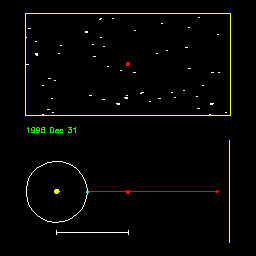 (hit "Refresh"
to make this animation go again)
(hit "Refresh"
to make this animation go again)
| DATE | Lecture 12 |
| TITLE | Measuring the Stars |
| READING | Chapter 11 |
| MAIN CONCEPTS | Parallax, Stellar Motions, Luminosity/Temperature, Spectral Formation/Classes |
Measuring the distance to objects in the sky is one of the most difficult measurements in Astronomy. The foundation of all distances is the Astronomical Unit (AU), which is now know quite well from direct radar reflection off Venus. To measure the distances to stars (whose intrinsic luminosity is not fixed and therefore requires a distance to know), we make use of parallax. This is just the change in the line-of-sight angle to the distant object that is induced by moving the observer over a known baseline. To measure this angle in the sky, one needs a fixed background reference frame against which to measure it; this is provided by very distant stars (whose parallax is unmeasurably small). The closer the object in question, the more it will appear to move against the background, so the larger will be its parallax. The fundamental baseline for stellar parallaxes is the AU, and the baseline shift is provided by the Earth's orbit. The units of the parallactic angle are "arc sec" or "seconds of arc"; 1 arc sec is 1/3600 of a degree (a degree is divided into 60 minutes of arc, and a minute is divided into 60 arc sec).
 (hit "Refresh"
to make this animation go again)
(hit "Refresh"
to make this animation go again)
One generally measures the position of a star against the background, then waits 6 months so that it will have its maximum shift. That makes a baseline of 2AU; the angle so measured will be twice the parallax. The distance to a star which exhibits a parallax p of 1 arc sec is called 1 parsec (pc, this is equivalent to about 3.26 light years). In general, d (pc) = 1/p (arc sec). Even the closest star to us (Proxima Centauri) has a smaller parallax than that. One arc sec is about the angle subtented by a nickel seen at a distance of 1 kilometer, so parallaxes are not easy to measure! The best we can do from the ground is about 100 pc, though new techniques are improving that. From space (without atmospheric turbulence) we can measure stars to several hundred pc, and there are experiments being designed that might extend the reach of "trigonometric parallax" to several thousand pc, putting much of the Galaxy finally within the reach of direct measurement.
Another method for measuring distance is the method of "standard candles" by applying the inverse square law. This requires knowing the intrinsic luminosty L of an object, then using the fact that the apparent brightness B of it will depend on the intrisic luminosity decreased by the square of the distance to it to deduce the distance. In the case of stars, we have found that main sequence stars of the same mass and age will have the same temperature and luminosity. Of course, to discover this we had to depend on measuring parallaxes to many nearby main sequence stars. But once calibrated, this method can be used to estimate the distance to more distant stars. There are other sorts of standard candles: pulsating stars and certain kinds of supernovae for example, but in each case we must independently establish the luminosity of the "candle" and that it really is "standard" (distant objects really have the same intrinsic luminosity). This is an ongoing struggle.
The intrinsic luminosity L of a star (the total amount of energy it emits) depends on the surface temperature T of the star and its size, or radius R. The star emits basically like a blackbody, and recall that the power emitted by a blackbody goes like T4. The surface area of the star which emits depends on R2, so that we have the relation L a R2 T4. This is useful in comparing how luminous stars of different sizes and temperatures will be compared to each other. The amount of energy a star emits actually depends on the nuclear fusion in its core, but it will adopt a certain size based on various conditions, and that will then lead to a certain surface temperature so all the energy produced in the center can be emitted at the surface.
The surface temperature will affect the spectrum that the star emits. It will govern the overall shape of the spectrum (like a blackbody), the color the star appears (which depends on the shape of the spectrum), and the sort of absorption lines that are seen in the spectrum. Because the spectrum is easier to measure than the actual size, luminosity, or temperature, we describe stars by their "spectral type". This is given by a letter, and ordered by surface temperature: from hotter to cooler the spectral types are OBAFGKMLT (the ordering is strange for historical reasons). The L & T spectral types were added only in 1998 (and are not in the text); they cover stars and brown dwarfs cooler than 2300K. See Table 12.3 for a brief summary of the temperatures and spectral lines in the various types. On the main sequence, the spectral sequence from hotter to cooler is also a sequence from higher to lower mass (~50 to .075 solar masses), more to less luminosity (106 to 10-4 solar luminosities), and larger to smaller radii.
A very nice further treatment of all these topics can be found in the Colorado site.